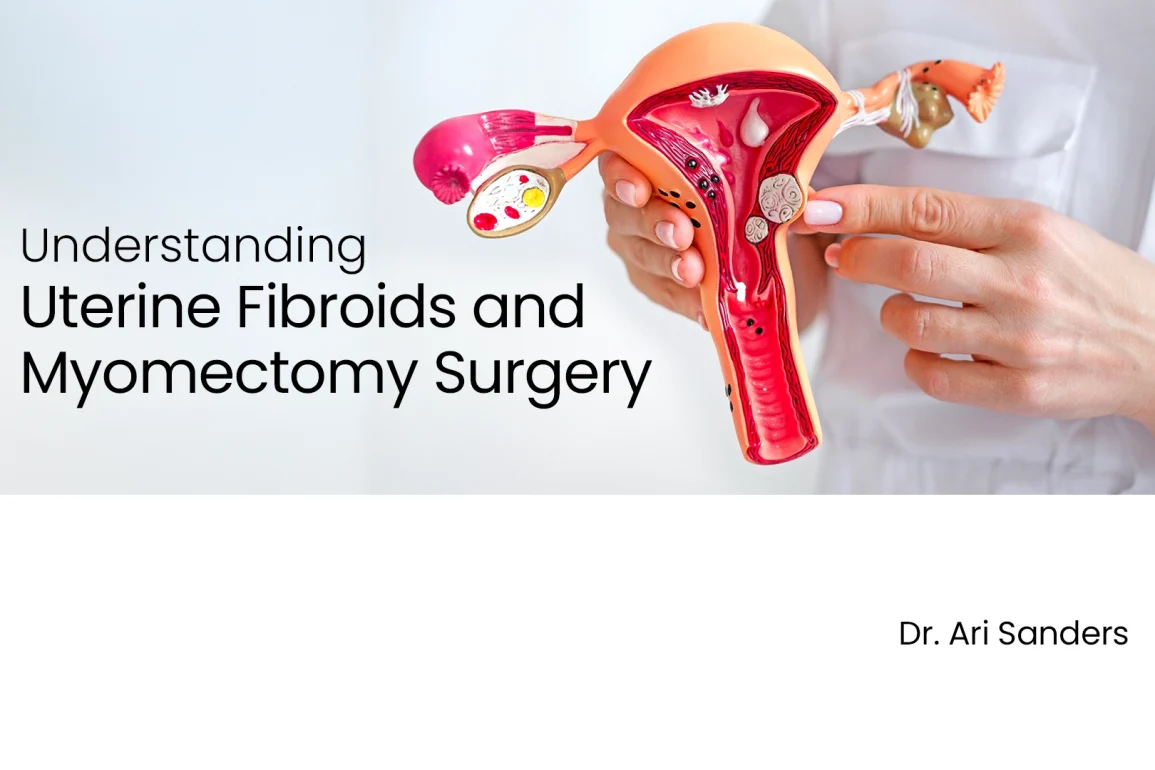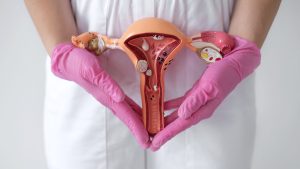Uterine fibroids are noncancerous growths that develop on or within the uterus. In medical settings, doctors often refer to them as leiomyomas or myomas.
According to a study published in the Journal of Obstetrics and Gynecology Canada, up to 70% of women will develop at least one fibroid before the age of 50. In many cases, they are entirely asymptomatic and require no treatment.
Around half of all women diagnosed with fibroids report debilitating side effects like severe pain/pressure or heavy bleeding. These symptoms can sometimes be severe enough to affect quality of life, work performance, and intimate relationships.
Patients who struggle with uterine fibroids don’t have to suffer. Modern treatment options, including medications and surgery (myomectomy or hysterectomy), can shrink or eliminate these growths, providing effective relief.
What Are Uterine Fibroids?
While fibroids are technically classified as a form of smooth muscle tumor, these growths are almost always benign.
Having fibroids doesn’t increase a patient’s overall risk for cancer within the reproductive organs or in any other areas of the body.
Types of Fibroids
- Intramural fibroids grow within the thick muscular wall that surrounds the uterus called the myometrium. This is the same area that causes cramping during menstrual cycles or contractions during childbirth.
- Submucosal fibroids protrude into the uterine cavity itself. They may grow near or attached to the endometrial lining—the part that sheds during a period.
- Subserosal fibroids occur just below the outer tissue layer that surrounds the uterus called the serosa. They are usually superficial and may even grow outwards into the abdominal cavity from a small stalk.
All fibroids can vary in size from as small as a grape to larger than a cantaloupe in extreme cases. Once they form, they can continue to grow. Patients who develop one fibroid are more likely to develop more as they age.
How Fibroids Affect Women
Many women with fibroids never experience any symptoms and don’t require any treatment at all. In fact, some patients only discover they have a growth during a routine gynecology appointment or after imaging for an unrelated issue.
For some women, fibroids can cause severe and debilitating symptoms that can lead to serious illness or become disabling enough to affect everyday life.
Common Fibroid Symptoms
- Heavy Menstrual Bleeding: Periods may become much heavier, contain large clots, or last longer than usual. Spotting or breakthrough bleeding may occur intermittently or on a regular basis, and can eventually result in anemia.
- Pelvic Pain and Pressure: Patients often complain of persistent discomfort or a feeling of fullness in the lower pelvic region. Pain can be mild or severe, and may present only during menstruation, or all the time.
- Frequent Urination: If fibroids put pressure on the bladder, patients might feel as if they need to urinate all the time. The feeling can sometimes mimic urinary tract infections, but urine cultures may come back inconclusive or negative.
- Constipation: Fibroids can also put pressure on the intestines and colon, making it harder to pass stool.
- Lower Back or Leg Pain: If fibroids press against critical nerve bundles in the abdomen or spine, patients may experience burning, numbness, tingling, or aching in the lower back or legs. The pain may mimic sciatica or feel like a herniated disk.
- Pain During Intercourse: Women with fibroids often report sharp, aching or sudden pain, sometimes with breakthrough bleeding, during intercourse. This can be persistent and severe enough to inhibit intimate relationships.
- Severe Menstrual Cramps: Fibroids, especially those that develop inside of the uterus, can worsen cramps during menstruation. Pain can be disabling enough to require time off work or limit everyday activities.
- Enlarged Abdomen: Very large fibroids can cause an increase in the size of the lower stomach. This may be confused for bloating, weight gain, or pregnancy.
- Fertility Issues: While the relationship between fibroids and fertility is not well understood, some patients may have difficulty conceiving, or may experience pregnancy complications.
It’s important to note that all of these symptoms can affect women differently. Some may find even the mildest of symptoms overwhelming, while others cope with more severe symptoms perfectly fine. Each person deserves to feel validated and should have access to treatment and support options that meet their needs.
What Causes Fibroids?
Scientists still don’t fully understand what causes fibroids to form or why they happen in some women, but not others. Most of the available research currently points to a combination of factors, such as lifestyle, hormone levels, and genetics.
- MED12 Gene Mutations: A March 2024 study concluded that genetic mutations in a gene called MED12 may be indirectly or directly responsible for up to 85% of all fibroids.
- Hormone levels: Estrogen and progesterone levels may play a role in how or when fibroids form. Both can promote the growth of fibroids.
- Pregnancy: Endogenous (natural) hormone levels in the body can shift during pregnancy, causing fibroids to form or expand. In some cases, they may shrink or even disappear after pregnancy ends.
Researchers continue to investigate what drives fibroids to form and how medicine can better help women cope. We learn more about them every year.
Other Risk Factors
- Familial Link: There is evidence to support the idea that fibroids run in families. If your sister, mother, or grandmother struggled with fibroids, you are more likely to develop them yourself within your lifetime.
- Age: Fibroids are extremely uncommon before the age of 20, and generally only form during a woman’s fertile years. Once patients enter menopause, their risk for new fibroid growth drops sharply.
- Obesity: Being overweight may raise your risk for developing fibroids. Excess body fat can increase estrogen levels, which may explain this connection.
- High Blood Pressure: Having high blood pressure may play a role in how fibroids develop. This may be related to the fact that most have their own blood supply.
- Race: Women of color, specifically those of African descent, are more likely to develop fibroids. They are also more likely to experience debilitating symptoms like severe pain or excessive bleeding.
What Is a Myomectomy?
A myomectomy is a surgical procedure to remove fibroids from on or around the uterus. Only the growth is removed, rather than the uterus itself, preserving the patient’s fertility and ability to menstruate. This option is often more ideal for women who still want to have children, but also need relief from bothersome symptoms.
Whether myomectomy surgery is invasive or non-invasive depends on how many fibroids a patient has, where they are located, and how difficult they are to remove. Generally, most procedures fall into one of the following three categories.
Abdominal
An abdominal myomectomy is considered major surgery. The surgeon will usually make a large incision in the lower abdomen (often called a “bikini cut”). This does result in a longer recovery time, but is more effective for large or complicated fibroids. Larger or more numerous fibroids may require an up and down cut in the middle of the abdomen.
Laparoscopic
Laparoscopic myomectomy is a less invasive surgical option than an open procedure. The surgeon will usually make a series of small incisions in the abdomen and use a laparoscope (camera) and additional laparoscopic instruments to excise and remove the fibroids. This can result in faster recovery times and less blood loss. Multiple factors determine which patients and fibroids can be removed laparoscopically.
Hysteroscopic
Hysteroscopic myomectomy is the least invasive of all three procedures. A surgeon passes a small device called a hysteroscope through the cervix and into the uterus to remove fibroids within the uterine cavity. Recovery time is minimal, but this procedure is only effective for fibroids that form within the uterine cavity itself.
Myomectomy vs. Other Treatments
How does myomectomy compare with other common treatments for fibroids, and how can you decide if it’s the right choice? Let’s start by exploring the pros and cons.
When is Myomectomy Recommended?
The decision to proceed with myomectomy should always start with a discussion between the patient and a qualified medical professional, as every woman’s situation is unique. However, myomectomy is typically recommended for women who want to preserve fertility and relieve symptoms without taking medication or losing their uterus.
The size, type, and location of fibroids may also make myomectomy more or less suitable for some patients. In extremely rare cases, fibroids may infiltrate the surrounding tissues so significantly that myomectomy alone isn’t sufficient.
What to Expect During & After Myomectomy Surgery
The journey to myomectomy starts with a full medical evaluation. Your provider will likely order blood work and imaging to determine your overall health and the current condition or position of your fibroids. You may have an ultrasound or MRI scan.
Before Your Procedure
- The night before your surgery, you’ll be asked to fast. That usually means having nothing to eat or drink after midnight.
- You may be allowed to drink clear fluids up to four to eight hours before your procedure. Ask your care team to confirm.
The Day of Your Surgery
- When you arrive at the hospital a care team will help you check in. A nurse will take your information, including your weight and height, and place an IV in your arm.
- You’ll be escorted to the surgical bay just before your procedure starts. An anaesthesiologist will briefly discuss the anesthesia process with you and answer any questions.
- Your care team will bring you into the operating room. They’ll prepare you for surgery and administer medication. You’ll feel drowsy and fall asleep.
If you have anxiety, or are concerned about pain after your procedure, let the anesthesiologist know. They can often help.
During Your Surgery:
- Your anesthesiologist will constantly monitor you while you are asleep. They will adjust your medication to keep you comfortable as needed.
- After the procedure is done, you’ll be moved to the recovery room. You’ll remain there until you wake up and your vitals are stable.
After Your Surgery:
- Depending on which type of myomectomy you have, you may be admitted to the hospital. Or, you may go home the same day.
- Your care team will give you instructions to follow, such as activity restrictions, proper wound care, and how or when to control pain.
- When you’re ready to leave, a nurse will fill out your discharge papers. In most cases, a support person will need to pick you up.
Myomectomy is an excellent choice for women who want relief from fibroids without sacrificing their fertility in the process. However, no surgical procedure is entirely without risk. Potential complications include infection, excessive bleeding, and damage to nearby organs, although these are extremely rare.
Your doctor can help you understand if the benefits of myomectomy outweigh the risks or if this procedure is right for you. They can also help you explore other treatments, like medication or embolization.
If fibroid symptoms are negatively affecting your life, don’t be afraid to ask for help. You don’t have to suffer in silence. No matter what option you choose, treatments are available that can provide relief and preserve your fertility. There is hope!
Resources:
https://www.yourperiod.ca/uterine-fibroids/what-causes-fibroids/
https://pubmed.ncbi.nlm.nih.gov/33067250/
https://www.frontiersin.org/journals/genetics/articles/10.3389/fgene.2024.1330807/full
https://pubs.rsna.org/doi/full/10.1148/radiol.211658








